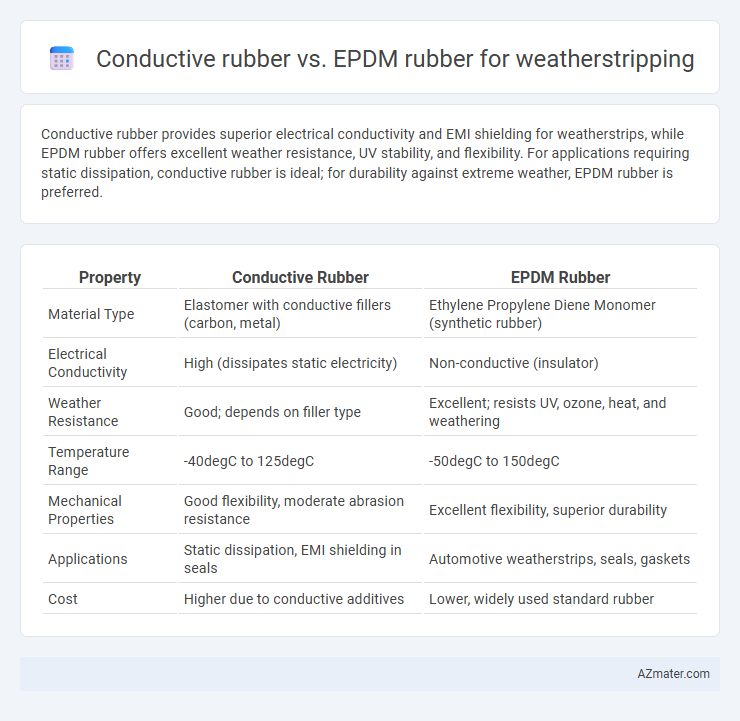Conductive rubber provides superior electrical conductivity and EMI shielding for weatherstrips, while EPDM rubber offers excellent weather resistance, UV stability, and flexibility. For applications requiring static dissipation, conductive rubber is ideal; for durability against extreme weather, EPDM rubber is preferred.
Table of Comparison
| Property | Conductive Rubber | EPDM Rubber |
|---|---|---|
| Material Type | Elastomer with conductive fillers (carbon, metal) | Ethylene Propylene Diene Monomer (synthetic rubber) |
| Electrical Conductivity | High (dissipates static electricity) | Non-conductive (insulator) |
| Weather Resistance | Good; depends on filler type | Excellent; resists UV, ozone, heat, and weathering |
| Temperature Range | -40degC to 125degC | -50degC to 150degC |
| Mechanical Properties | Good flexibility, moderate abrasion resistance | Excellent flexibility, superior durability |
| Applications | Static dissipation, EMI shielding in seals | Automotive weatherstrips, seals, gaskets |
| Cost | Higher due to conductive additives | Lower, widely used standard rubber |
Introduction to Weatherstrip Materials
Conductive rubber and EPDM rubber are commonly used materials for weatherstrip applications due to their distinct properties. Conductive rubber offers excellent electrical conductivity and static dissipation, making it ideal for environments requiring EMI shielding or grounding. EPDM rubber provides superior weather resistance, UV stability, and flexibility, making it highly effective in sealing against moisture, dust, and temperature extremes in outdoor and automotive weatherstripping.
Overview of Conductive Rubber
Conductive rubber used in weatherstrips typically incorporates carbon or metallic fillers to provide electrical conductivity, enhancing static dissipation and electromagnetic interference shielding. This type of rubber offers durability, flexibility, and excellent resistance to weathering, making it ideal for automotive and electronic enclosure seals. Compared to EPDM rubber, conductive rubber excels in applications requiring both environmental sealing and electrical functionality.
Overview of EPDM Rubber
EPDM rubber is a synthetic elastomer prized for its exceptional weather resistance, including superior performance against UV rays, ozone, and extreme temperatures ranging from -40degC to 125degC. Commonly used in weatherstripping applications, EPDM provides excellent flexibility, durability, and water resistance, making it ideal for sealing automotive doors, windows, and industrial equipment. Unlike conductive rubber, EPDM lacks electrical conductivity but offers enhanced resistance to environmental degradation and chemical exposure.
Key Properties Comparison
Conductive rubber offers excellent electrical conductivity and static dissipation, making it ideal for applications requiring EMI shielding or grounding, whereas EPDM rubber excels in weather resistance, ozone resistance, and UV stability, ensuring long-term durability in outdoor weatherstripping. EPDM's superior flexibility and temperature tolerance from -40degC to 125degC provide reliable sealing against water, dust, and air infiltration, while conductive rubber, often formulated with carbon or metal fillers, typically sacrifices some elasticity for enhanced conductivity. The choice between conductive and EPDM rubber for weatherstripping hinges on whether electrical performance or environmental resilience is the primary requirement.
Conductive Rubber: Advantages and Applications
Conductive rubber offers superior electrical conductivity, making it ideal for weatherstripping in electronic enclosures where electromagnetic interference (EMI) shielding is critical. Its ability to dissipate static electricity enhances device protection, extends component lifespan, and maintains signal integrity in sensitive equipment. Common applications include sealing of electronic cabinets, automotive sensors, and communication devices requiring reliable grounding and EMI shielding performance.
EPDM Rubber: Advantages and Applications
EPDM rubber offers superior weather resistance, excellent flexibility, and outstanding ozone and UV protection, making it ideal for weatherstripping in automotive and construction industries. It maintains its sealing properties under extreme temperatures ranging from -40degC to 125degC, ensuring long-term durability and energy efficiency. EPDM's chemical resistance to water, steam, and various cleaners enhances its application in window seals, door gaskets, and industrial weatherstrips, outperforming conductive rubber in environmental resilience.
Performance in Extreme Weather Conditions
Conductive rubber offers superior performance in extreme weather conditions due to its excellent electrical conductivity and resistance to static buildup, making it ideal for environments prone to electrical interference or discharge. EPDM rubber excels in weatherstrip applications with exceptional resistance to UV radiation, ozone, and temperature extremes ranging from -40degC to 150degC, ensuring long-term durability and flexibility. While conductive rubber is preferred for applications requiring static dissipation, EPDM provides unmatched resilience against harsh weathering, maintaining seal integrity in both hot and cold climates.
Durability and Maintenance Considerations
Conductive rubber offers enhanced durability due to its resistance to environmental factors like moisture and UV radiation, making it ideal for weatherstripping applications that require consistent electrical conductivity. EPDM rubber excels in weather resistance, maintaining flexibility and performance under extreme temperatures and prolonged UV exposure, which reduces maintenance frequency. While conductive rubber may require occasional inspection for wear affecting conductivity, EPDM requires minimal maintenance, providing long-lasting sealing and weatherproofing benefits.
Cost Effectiveness and Availability
Conductive rubber offers enhanced electrical conductivity for weatherstripping applications, but it generally comes at a higher cost and limited availability compared to EPDM rubber. EPDM rubber remains the most cost-effective and widely available option, providing excellent resistance to weathering, UV rays, and ozone, making it ideal for standard weatherstrip needs. Selecting EPDM rubber maximizes value through affordability and broad market presence, while conductive rubber suits specialized applications requiring electrostatic discharge protection.
Choosing the Right Weatherstrip Rubber
Choosing the right weatherstrip rubber between conductive rubber and EPDM rubber depends on application-specific requirements such as electrical conductivity and weather resistance. Conductive rubber is ideal for environments needing static dissipation or EMI shielding, while EPDM rubber excels in UV, ozone, and temperature resistance, making it suitable for exterior weatherstripping. Consider factors like durability, sealing performance, and environmental exposure to optimize weatherstrip effectiveness and longevity.

Infographic: Conductive rubber vs EPDM rubber for Weatherstrip
 azmater.com
azmater.com